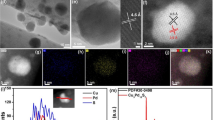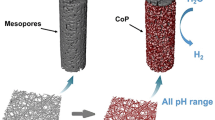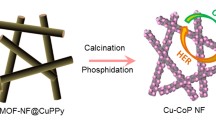Abstract
Inspired by the excellent activity of platinum in hydrogen evolution reaction (HER) and the good performance of Ni-based compounds in oxygen evolution reaction (OER), a bifunctional electrocatalyst PtNi carbon nanofiber (CNF) is designed and fabricated using electrospinning followed by carbonization. Ultra-small PtNi nanoparticles of several nanometers in size are densely dispersed on every CNF, along with a few larger nanoparticles with sizes of several decades of nanometers. The as-prepared catalysts can be directly used as an electrode and act as high-efficiency materials for water splitting, including HER and OER. For HER activity, the PtNi/CNFs reach 10 mA cm−2 current density at low overpotentials of 34 mV and exhibit a small Tafel slope of 31 mV dec−1 in acidic electrolytes of 0.5 M H2SO4, which is close to that of commercial Pt/C (20 wt%) electrocatalytic catalysts. In 1 M KOH solution, the PtNi/CNFs also exhibit excellent HER activity with a low overpotential of 82 mV to achieve a current density of 10 mA cm−2 and a small Tafel slope of 34 mV dec−1. Moreover, the PtNi/CNFs also show good activity for OER in alkaline electrolyte of 1 M KOH with a Tafel slope of 159 mV dec−1 and a small overpotential of 151 mV to reach a current density of 10 mA cm−2. In addition, the OER performance of the PtNi/CNFs in acid media is also favorable, with a 198 mV dec−1 Tafel slope. The decent activity of the PtNi/CNFs for water splitting originates from the synergistic effects of using Pt and Ni, large amounts of ultra-small nanoparticles densely dispersed on the CNFs, high conductivity of the support materials and interconnected three-dimensional structures of the carbon nanofiber mats.





Similar content being viewed by others
References
Cobo S, Heidkamp J, Jacques P et al (2012) A Janus cobalt-based catalytic material for electro-splitting of water. Nat Mater 11:802–807
Yamaguchi A, Inuzuka R, Takashima T et al (2011) Regulating proton-coupled electron transfer for efficient water splitting by manganese oxides at neutral pH. Nat Commun 5:4256
Chen S, Qiao SZ (2013) Hierarchically porous nitrogen-doped graphene-NiCo2O4 hybrid paper as an advanced electrocatalytic water-splitting material. ACS Nano 7:10190–10196
Song F, Hu X (2014) Ultrathin cobalt–manganese layered double hydroxide is an efficient oxygen evolution catalyst. J Am Chem Soc 136:16481–16484
Jiao F, Frei H (2009) Nanostructured cobalt oxide clusters in mesoporous silica as efficient oxygen-evolving catalysts. Angew Chem 48:1841–1844
Wang T, Guo Y, Zhou Z et al (1936) Ni-Mo nanocatalysts on N-doped graphite nanotubes for highly efficient electrochemical hydrogen evolution in acid. ACS Nano 10:10397–10403
Yin J, Fan Q, Li Y et al (2016) Ni–C–N Nanosheets as catalyst for hydrogen evolution reaction. J Am Chem Soc 138:14546–14549
Cheng Y, Jiang SP (2013) Highly effective and CO-tolerant PtRu electrocatalysts supported on poly(ethyleneimine) functionalized carbon nanotubes for direct methanol fuel cells. Electrochim Acta 99:124–132
Mohtadi-Bonab MA, Szpunar JA, Razavi-Tousi SS (2013) Hydrogen induced cracking susceptibility in different layers of a hot rolled X70 pipeline steel. Int J Hydrogen Energy 38:13831–13841
Suh WK, Ganesan P, Son B et al (2016) Graphene supported Pt–Ni nanoparticles for oxygen reduction reaction in acidic electrolyte. Int J Hydrogen Energy 41:12983–12994
Rosado G, Verde Y, Valenzuela-Muñiz AM et al (2016) Catalytic activity of Pt-Ni nanoparticles supported on multi-walled carbon nanotubes for the oxygen reduction reaction. Int J Hydrogen Energy 41:12983–12994
Binghong Han E, Carlton C, Kongkanand Anusorn et al (2015) Record activity and stability of dealloyed bimetallic catalysts for proton exchange membrane fuel cells. Environ Eng Sci 8:258–266
Trogadas P, Fuller TF, Strasser P (2014) Carbon as catalyst and support for electrochemical energy conversion. Carbon 75:5–42
Ren J, Antonietti M, Fellinger TP (2014) Efficient water splitting using a simple Ni/N/C paper electrocatalyst. Adv Energy Mater 5:1614–6840
David S, Isabel S, Elena P et al (2013) The effect of carbon nanofiber properties as support for PtRu nanoparticles on the electrooxidation of alcohols. Appl Catal B-Environ 132:13–21
Yu LH, Kuo CH, Chuin TY et al (2007) Poly(vinylpyrrolidone)-modified graphite carbon nanofibers as promising supports for PtRu catalysts in direct methanol fuel cells. J Am Chem Soc 129:9999–10010
Hernándezpagán EA, Vargasbarbosa NM, Wang TH et al (2012) Resistance and polarization losses in aqueous buffer–membrane electrolytes for water-splitting photoelectrochemical cells. Environ Eng Sci 5:7582–7589
Huang X, Zhao Z, Cao L et al (2015) High-performance transition metal-doped Pt3Ni octahedra for oxygen reduction reaction. Science 348:1230–1234
Chen C, Kang Y, Huo Z et al (2014) Highly crystalline multimetallic nanoframes with three-dimensional electrocatalytic surfaces. Science 343:1339–1343
Li M, Zhao Z, Cheng T et al (2016) Ultrafine jagged platinum nanowires enable ultrahigh mass activity for the oxygen reduction reaction. Science 354:1414–1419
Oh A, Sa YJ, Hwang H et al (2016) Rational design of Pt–Ni–Co ternary alloy nanoframe crystals as highly efficient catalysts toward the alkaline hydrogen evolution reaction. Nanoscale 8:16379–16386
Wang Q, Yanzhang R, Wu Y et al (2016) Silk-derived graphene-like carbon with high electrocatalytic activity for oxygen reduction reaction. Rsc Adv 6:34219–34224
Wang J, Zhu H, Chen JD et al (2016) Small and well-dispersed Cu nanoparticles on carbon nanofibers: self-supported electrode materials for efficient hydrogen evolution reaction. Int J Hydrogen Energy 41:18044–18049
Strasser P (2016) Free electrons to molecular bonds and back: closing the energetic oxygen reduction (ORR)-oxygen evolution (OER) cycle using core-shell nanoelectrocatalysts. Acc Chem Res 49:2658–2668
Niu Z, Becknell N, Yu Y et al (2016) Anisotropic phase segregation and migration of Pt in nanocrystals en route to nanoframe catalysts. Nat Mater 15:1188–1194
Chen WF, Wang CH, Sasaki K et al (2013) Highly active and durable nanostructured molybdenum carbide electrocatalysts for hydrogen production. Environ Eng Sci 6:943–951
Zeng K, Zhang D (2010) Recent progress in alkaline water electrolysis for hydrogen production and applications. Prog Energy Combust 36:307–326
Sheng W, Zhuang Z, Gao M et al (2015) Correlating hydrogen oxidation and evolution activity on platinum at different pH with measured hydrogen binding energy. Nat Commun 6:5848
Mckone JR, Sadtler BF, Werlang CA et al (2013) Ni–Mo nanopowders for efficient electrochemical hydrogen evolution. Acs Catal 3:166–169
Zhu H, Gu L, Yu D et al (2017) The marriage and integration of nanostructures with different dimensions for synergistic electrocatalysis. Energy Environ Sci 10:321–330
Deng D, Novoselov KS, Qiang F et al (2016) Catalysis with two-dimensional materials and their heterostructures. Nat Nanotechnol 11:218–230
Deng J, Ren P, Deng D et al (2015) Enhanced electron penetration through an ultrathin graphene layer for highly efficient catalysis of the hydrogen evolution reaction. Angew Chem 54:2100–2104
Liang H, Gandi AN, Anjum DH et al (2016) Plasma-assisted synthesis of NiCoP for efficient water splitting. Nano Lett 16:7718–7725
Lin G, Heggen M, O’Malley R et al (2013) Understanding and controlling nanoporosity formation for improving the stability of bimetallic fuel cell catalysts. Nano Lett 13:1131–1138
Author information
Authors and Affiliations
Corresponding author
Electronic supplementary material
Below is the link to the electronic supplementary material.
Rights and permissions
About this article
Cite this article
Chen, J., Wang, J., Chen, J. et al. A bifunctional electrocatalyst of PtNi nanoparticles immobilized on three-dimensional carbon nanofiber mats for efficient and stable water splitting in both acid and basic media. J Mater Sci 52, 13064–13077 (2017). https://doi.org/10.1007/s10853-017-1410-1
Received:
Accepted:
Published:
Issue Date:
DOI: https://doi.org/10.1007/s10853-017-1410-1




